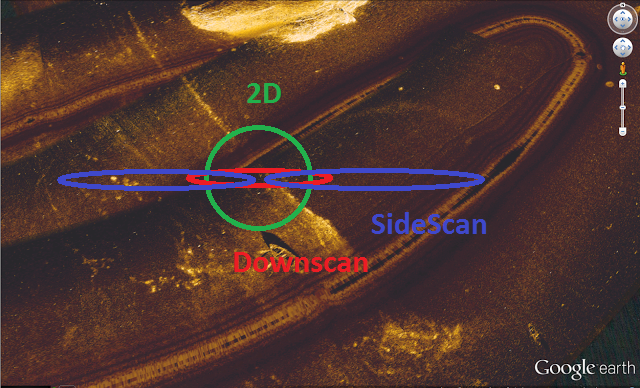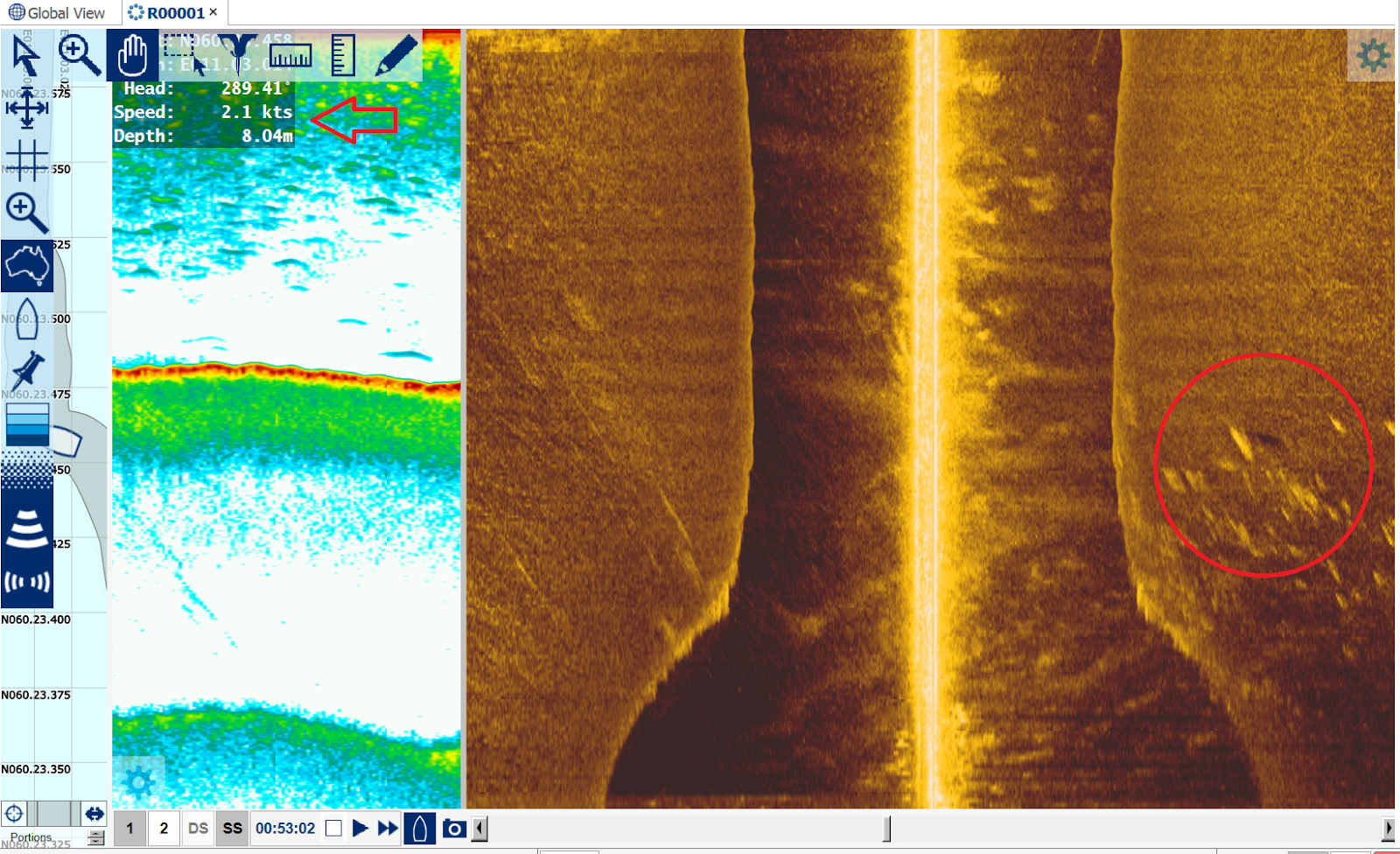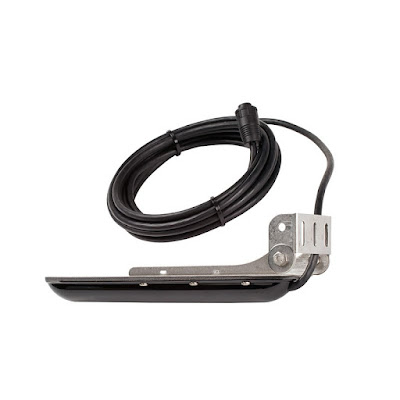After the introduction of Simrad and Lowrance take on the "all in one"-transducer, TotalScan, we have recived several questions on what our preferred setup would be when it comes to scanning sonar. Here I will try to answer these questions. We will look at the technical differences, and how that transforms to practical differences out on the water.
Let us start with the tech, What are these ducers?
They are all ducers for scanning sonar, ie they use high frequenzies and narrow conenagles to produce a photo-like image of what is under the surface. Scanning sonar for recreational fishing typically consists of sonar looking down (DownScan) and/ or sonar looking to both sides of the boat (SideScan). Lowrance and Simrad use the term StructureScan for both.
In the image below I`m trying to show you how the difference in coneangles (and -shape) of 2D, DownScan and SideScan effects what you are looking at.
Here are a few screenshots showing what to expect:
The first one is the classic 2D-view. We see the fish as arches (as long as the boat is moving) and bottom-structure drawn as a line on the screen. From the size, shape and colour of the arches we can guess how far from the ducer the fish are, and in som cases even what size they are. From looking at how the bottom-structure is drawn, we can guess bottom-composition (soft or hard).
Switching to downscan, we leave the more or less perfect circle of the 2D-cone and venture into a cone so oval it is more like a strobe. The frequenzy also increases, leaving us a much more detailed, but also very different look. First we look at 2D and downscan side-by side. 2D to the left, DownScan to the right:
Moving on to SideScan, and thereby moving from sonar looking DOWN to sonar looking SIDEWAYS as well. As with Downscan, we will start with an image showing 2D and SideScan:
On the 2D we see some fish, buth with the wide perspective of SideScan we see a lot more. On both sides of the boat there are large shoals of baitfish (green circles) and even one larger fish. In the midle of the SideScan-image you see a white line, this is effectively the course of the boat since we are looking aproximately 45 degrees out to each side of the boat. You see the watercoloumn (and fish) and then the bottom (rather dull in this image).
On the image below you see a few larger fish (yellow perch) on Humminbirds SideImaging, Humminbirds take on the same technology. (The image is taken from a sonarlog used in Reefmaster.)
The first image in this article (the one with coneangles) was made from a sonarlog of SideScan. The same wreck as seen there and with Downscan, looks like this on SideScan:
To summarize, scanning sonar is a great tool when looking for both structure and fish, and suplements our 2D-sonar well. But in order to make the most of this tech, we need to take care when setting up the ducer, and learn the basics of how it works so we can decipher the image and use the information for our needs.
HDI
HDI, or Hybrid Dual Imaging, came to light when the range of models called Elite HDI was introduced. It combines one element for 2D-sonar (the "normal" sonar) and one element for DownScan. As a result, this ducer is not capable of producing SideScan, even if it is connected to a sonar-unit with such capabilities.
The HDI-ducers come in four versions. Two different 2D-elements, and two different plugs/ connectors. The two connectors are the blue 7-pin (as in the pic above) and the black 9-pin, choose the connector that fits your sonarunit. (There are adapters available as well.) The name of the ducer tells you which 2D-element it has, both have the same DownScan-element.
Since both 83/200/455/800-HDI and 50/200/455/800-HDI use the same DownScan-element, there is no difference in the DownScan-images produced. You have two DownScan-frequenzies to choose from, 455 and 800 kHz. 455 has a sligthly wider coneangle, and the lower frequenzy has less signalloss in deeper water. 800 has a sligthly more narrow coneangle covering a smaller area under your boat, but will normally give the sharpest images in shallow water.
83/200/455/800-HDI is the most common model, often sold in package-deals with compatible units. For 2D it is capable of 83 and 200 kHz with coneangles 52 and 22 degrees measured at -3db. It can also be used with medium chirp and high chirp for 2D on sonarmodels that are chirp-capable.
50/200/455/800-HDI is often referred to as a "saltwater model". This is due to its more narrow coneangles for 2D, a lower low-frequenzy and because the larger 2D-element (compared to 83/200) can handle more power. But there are a lot of freshwater-anglers using the 50/200/455/800-HDI with success as well. Personaly I prefer it over 83/200/455/800-HDI, because of its narrow coneangles and more sensitive 2D-element.
50 kHz has a coneangle of 29 and 200 kHz a coneangle of 12. With a chirp-capable sonarunit, the 50/200/455/800-HDI can be used in low chirp and high chirp as well.
The HDI-ducers are good choices for small boats that do not have room for both a 2D-ducer and LSS-2 on the transom, and for users that does not feel the need for SideScan. It can also be mounted under a trollingmotor, using a special bracket.
Before HDI Lowrance had another small (ish) ducer cabable of DownScan called DSI. DSI (DownScan Imaging) was used with early Elite models, and can only produce downscan, not 2D.
As of right now, the following models from Lowrance are fully compatible with the HDI-ducers:
Totalscan
TotalScan is the "all in one"-alternative, and uses the 9-pin black connector. Like HDI it has elements for 2D and DownScan, but it also has elements for SideScan. This makes for easy installation, especially on small boats with limited space at the transom for multiple transducers. But it can also be negative, in order to have 2D-readings while on plane the Totalscan has to be placed low enough, making it more exposed as well. Proper installation and exact adjustement are key factors here.
TotalScan is only available with the black 9-pin connector, and will not give full functionality if used with the 9 to 7 pin adaptercable. This is a long and heavy ducer, so extra care should be taken when mounting it. TotalScan is a good choice for small boats that do not have room for both a 2D-ducer and LSS-2 on the transom, for mounting on the side of the boat (for vertical fishing) and under the trollingmotor. (Although mounting under the TM requires another bracket.)
The following models are fully compatible
LSS-2
LSS-2 gives you DownScan and SideScan in both 455 and 800 kHz, but no 2D. It uses the black 9-pin connector. Its predecessor LSS-1 is very much like the LSS-2, but it is smaller. The LSS-2 requires a second ducer for 2D (normal sonar), which is both good and bad. The good beeing that you can place the two independently of eachother, and choose the 2D-ducer you like. You can also have your 2D-ducer low in order to have good on-plane readings, and your LSS placed higher to keep it out of harms way while keeping that throotle down. (Downscan/ SideScan is not good for readings while on plane anyway.)
The following units are compatible without a module:
The following units are compatible with a module:
The older HDS-models HDS Gen 1 and HDS Gen 2 requires the use of a module to use LSS-2. Such modules are StructureScan HD and Sonarhub.
StructureScan 3D (SS3D)
This is the newest and most expencive alternative, both by its own account and since it requires a newer HDS-unit as well. As with LSS-2 you will need a seperate ducer for 2D.
SS3D has one extra set of cheramic elements versus LSS-2. These extra elements only recive accoustic signals, they do not send like the other elements does. The point in doing this is to be able to recive the echo from another angle then what is possible with LSS-2. In doing so two things are accomplished.
The SS3D is the same length and with as LSS-2, but the extra elements make it thicker. In the image below I compare SS3D with LSS-1, the predeccessor of LSS-2:
SS3D reqires both the ducer and the module. The ducer connects to the module using TWO 9-pin connectors, one for the elemnts both sending and reciving and one for the elements that only recive. It is when the software in the moduel compares these two, the advantage of SS3D is made possible.
SS3D is good choice for anyone depending on SideScan. The added range and detail compared to LSS-2 is noticable, and the 3D-function makes interpreting the image a lot easier. But the share size of the ducer combined with the added tech of the module, can make it a challenge to mount on smaller boats.
The following models are fully compatible but requires a module:
Earlier HDS models like HDS Gen 2 and HDS Gen 2 Touch can be used with SideScan and DownScan from the StructureScan 3D module med ducer, but can not show the 3D-view.
Moving on from the tech, which one should you choose and why?
Offcourse the full package with HDS-units, a good 2D-ducer and SS 3D outshines the alternatives, but it comes with a pricetag to mach the performance. At the moment I see noe alternatives on the market that deliver the same quality images form SideScan at long ranges then SS 3D. The dowscan is the same as with LSS-2, but the SideScan is a big improvement. I would not call it a "game-changer" but it is definitely a big improvement. So if SideScan is important for your fishing, it is time to dig into your wallet.
Due to its size and price, SS 3D is probably noot a good alternative on small boats or boats that see a lot of timber or rocks. If used in such areas, the ducer should at least be mounted high enough to be out of the water while on plane.
That said, I see no difference between DownScan/ SideScan from LSS-2 and that from TotalScan. In theory the TotalScan should give slightly less sharp images, due to it having shorter cheramic elements inside, but out on the water I can not say I see any difference. So if space (or budget) is to tight for both a 2D-ducer and LSS-2 (or SS3D) TotalScan could be a good choice. The 2D from TotalScan is the same as from 83/200/455/800-HDI or HST-WSBL.
If the budget is thight, or space for mounting the ducer is limited like under a trollingmotor, the HDI-ducer is a good alternative. It has been around for quite some time, has a reasonable price, and does what it says on the box. Personally I use HDI-ducers for my mobile-setup, used when icefishing or when renting a boat without sonar.
2D from 83/200/455/800-HDI is similar to 2D from HST-WSBL while 2D from 50/200/455/800-HDI is similar to HST-DFSBL. Considering the small size of the ducer the downscan is pretty good:
Läs mer...
(Detta inlägg har postats automatiskt)
Let us start with the tech, What are these ducers?
They are all ducers for scanning sonar, ie they use high frequenzies and narrow conenagles to produce a photo-like image of what is under the surface. Scanning sonar for recreational fishing typically consists of sonar looking down (DownScan) and/ or sonar looking to both sides of the boat (SideScan). Lowrance and Simrad use the term StructureScan for both.
In the image below I`m trying to show you how the difference in coneangles (and -shape) of 2D, DownScan and SideScan effects what you are looking at.
Here are a few screenshots showing what to expect:
The first one is the classic 2D-view. We see the fish as arches (as long as the boat is moving) and bottom-structure drawn as a line on the screen. From the size, shape and colour of the arches we can guess how far from the ducer the fish are, and in som cases even what size they are. From looking at how the bottom-structure is drawn, we can guess bottom-composition (soft or hard).
Switching to downscan, we leave the more or less perfect circle of the 2D-cone and venture into a cone so oval it is more like a strobe. The frequenzy also increases, leaving us a much more detailed, but also very different look. First we look at 2D and downscan side-by side. 2D to the left, DownScan to the right:
In the image above we are looking at a shoal of small baitfish. The fish are small and sit to close to eachother for the 2D to separate them and they look like what anglers referr to as a "baitball". In Downscan we see the single fish, and even a log or stick in the midle of the shoal. (black circle). And this is where DownScan really sets it self apart from 2D, details in relatively shallow water (down to 60 meters or so depending on conditions.) With DownScan you can look at a brushpile, and see if there is fish in the brushpile. The fish will not show as the classic arches, but look more like small dots.
In the image above you are looking at the same shipwreck as in the first image in this article (the one with the coneangles). You can easily make out the railing on top of the deck and you see the top of the ships hut at the back. The same wreck in 2D:
On the left side of the screen you see 200 kHz with its rather narrow coneangle of 11 degrees (measured at -3db), while the right side of the screen is 50 kHz with a whopping 45 degrees coneangle. (You can read the full spec of the P66 from Airmar HERE.) This screenshot clearly shows you how a narrow versus wide coneangle affects how your sonar reads and draws the bottom line. With 200 kHz the wreck clearly rizes from the bottom, while the wide coneangle of the 50 kHz makes it disapear in the bottom line. On 50 kHz we can only see a faint hint of the wreck since the bottom line thickens slightly where the wreck is, due to the wrecks harder return of the acoustic signal then the surrounding (softer) bottom. (These screenshots are from an article on wreckhunting, you can read the full article HERE.)Moving on to SideScan, and thereby moving from sonar looking DOWN to sonar looking SIDEWAYS as well. As with Downscan, we will start with an image showing 2D and SideScan:
On the image below you see a few larger fish (yellow perch) on Humminbirds SideImaging, Humminbirds take on the same technology. (The image is taken from a sonarlog used in Reefmaster.)
The first image in this article (the one with coneangles) was made from a sonarlog of SideScan. The same wreck as seen there and with Downscan, looks like this on SideScan:
To summarize, scanning sonar is a great tool when looking for both structure and fish, and suplements our 2D-sonar well. But in order to make the most of this tech, we need to take care when setting up the ducer, and learn the basics of how it works so we can decipher the image and use the information for our needs.
HDI
HDI, or Hybrid Dual Imaging, came to light when the range of models called Elite HDI was introduced. It combines one element for 2D-sonar (the "normal" sonar) and one element for DownScan. As a result, this ducer is not capable of producing SideScan, even if it is connected to a sonar-unit with such capabilities.
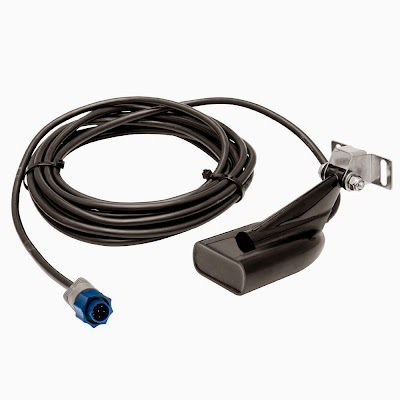 |
| 83/200/455/800-HDI with ble 7-pin connector |
The HDI-ducers come in four versions. Two different 2D-elements, and two different plugs/ connectors. The two connectors are the blue 7-pin (as in the pic above) and the black 9-pin, choose the connector that fits your sonarunit. (There are adapters available as well.) The name of the ducer tells you which 2D-element it has, both have the same DownScan-element.
Since both 83/200/455/800-HDI and 50/200/455/800-HDI use the same DownScan-element, there is no difference in the DownScan-images produced. You have two DownScan-frequenzies to choose from, 455 and 800 kHz. 455 has a sligthly wider coneangle, and the lower frequenzy has less signalloss in deeper water. 800 has a sligthly more narrow coneangle covering a smaller area under your boat, but will normally give the sharpest images in shallow water.
83/200/455/800-HDI is the most common model, often sold in package-deals with compatible units. For 2D it is capable of 83 and 200 kHz with coneangles 52 and 22 degrees measured at -3db. It can also be used with medium chirp and high chirp for 2D on sonarmodels that are chirp-capable.
50/200/455/800-HDI is often referred to as a "saltwater model". This is due to its more narrow coneangles for 2D, a lower low-frequenzy and because the larger 2D-element (compared to 83/200) can handle more power. But there are a lot of freshwater-anglers using the 50/200/455/800-HDI with success as well. Personaly I prefer it over 83/200/455/800-HDI, because of its narrow coneangles and more sensitive 2D-element.
50 kHz has a coneangle of 29 and 200 kHz a coneangle of 12. With a chirp-capable sonarunit, the 50/200/455/800-HDI can be used in low chirp and high chirp as well.
The HDI-ducers are good choices for small boats that do not have room for both a 2D-ducer and LSS-2 on the transom, and for users that does not feel the need for SideScan. It can also be mounted under a trollingmotor, using a special bracket.
Before HDI Lowrance had another small (ish) ducer cabable of DownScan called DSI. DSI (DownScan Imaging) was used with early Elite models, and can only produce downscan, not 2D.
As of right now, the following models from Lowrance are fully compatible with the HDI-ducers:
- Elite HDI
- Elite CHIRP
- Hook (not Hook 3x)
- HDS Gen 2 Touch
- HDS Gen 3
- HDS Carbon
Totalscan
TotalScan is the "all in one"-alternative, and uses the 9-pin black connector. Like HDI it has elements for 2D and DownScan, but it also has elements for SideScan. This makes for easy installation, especially on small boats with limited space at the transom for multiple transducers. But it can also be negative, in order to have 2D-readings while on plane the Totalscan has to be placed low enough, making it more exposed as well. Proper installation and exact adjustement are key factors here.
TotalScan is only available with the black 9-pin connector, and will not give full functionality if used with the 9 to 7 pin adaptercable. This is a long and heavy ducer, so extra care should be taken when mounting it. TotalScan is a good choice for small boats that do not have room for both a 2D-ducer and LSS-2 on the transom, for mounting on the side of the boat (for vertical fishing) and under the trollingmotor. (Although mounting under the TM requires another bracket.)
The following models are fully compatible
- Elite Ti
- HDS Gen 3
- HDS Carbon
LSS-2
LSS-2 gives you DownScan and SideScan in both 455 and 800 kHz, but no 2D. It uses the black 9-pin connector. Its predecessor LSS-1 is very much like the LSS-2, but it is smaller. The LSS-2 requires a second ducer for 2D (normal sonar), which is both good and bad. The good beeing that you can place the two independently of eachother, and choose the 2D-ducer you like. You can also have your 2D-ducer low in order to have good on-plane readings, and your LSS placed higher to keep it out of harms way while keeping that throotle down. (Downscan/ SideScan is not good for readings while on plane anyway.)
The following units are compatible without a module:
- HDS Gen 2 Touch
- HDS Gen 3
- HDS Carbon
The following units are compatible with a module:
- HDS Gen 1
- HDS Gen 2
The older HDS-models HDS Gen 1 and HDS Gen 2 requires the use of a module to use LSS-2. Such modules are StructureScan HD and Sonarhub.
StructureScan 3D (SS3D)
This is the newest and most expencive alternative, both by its own account and since it requires a newer HDS-unit as well. As with LSS-2 you will need a seperate ducer for 2D.
SS3D has one extra set of cheramic elements versus LSS-2. These extra elements only recive accoustic signals, they do not send like the other elements does. The point in doing this is to be able to recive the echo from another angle then what is possible with LSS-2. In doing so two things are accomplished.
- By calculating the difference in angle and time between the reciving elements one can render a 3D-image.
- By reciving the echo from another angle, echos that would otherwize not be recived are now recived and processed, giving more detail and range.
The SS3D is the same length and with as LSS-2, but the extra elements make it thicker. In the image below I compare SS3D with LSS-1, the predeccessor of LSS-2:
SS3D reqires both the ducer and the module. The ducer connects to the module using TWO 9-pin connectors, one for the elemnts both sending and reciving and one for the elements that only recive. It is when the software in the moduel compares these two, the advantage of SS3D is made possible.
SS3D is good choice for anyone depending on SideScan. The added range and detail compared to LSS-2 is noticable, and the 3D-function makes interpreting the image a lot easier. But the share size of the ducer combined with the added tech of the module, can make it a challenge to mount on smaller boats.
The following models are fully compatible but requires a module:
- HDS Gen 3
- HDS Carbon
Earlier HDS models like HDS Gen 2 and HDS Gen 2 Touch can be used with SideScan and DownScan from the StructureScan 3D module med ducer, but can not show the 3D-view.
Moving on from the tech, which one should you choose and why?
Offcourse the full package with HDS-units, a good 2D-ducer and SS 3D outshines the alternatives, but it comes with a pricetag to mach the performance. At the moment I see noe alternatives on the market that deliver the same quality images form SideScan at long ranges then SS 3D. The dowscan is the same as with LSS-2, but the SideScan is a big improvement. I would not call it a "game-changer" but it is definitely a big improvement. So if SideScan is important for your fishing, it is time to dig into your wallet.
Due to its size and price, SS 3D is probably noot a good alternative on small boats or boats that see a lot of timber or rocks. If used in such areas, the ducer should at least be mounted high enough to be out of the water while on plane.
That said, I see no difference between DownScan/ SideScan from LSS-2 and that from TotalScan. In theory the TotalScan should give slightly less sharp images, due to it having shorter cheramic elements inside, but out on the water I can not say I see any difference. So if space (or budget) is to tight for both a 2D-ducer and LSS-2 (or SS3D) TotalScan could be a good choice. The 2D from TotalScan is the same as from 83/200/455/800-HDI or HST-WSBL.
If the budget is thight, or space for mounting the ducer is limited like under a trollingmotor, the HDI-ducer is a good alternative. It has been around for quite some time, has a reasonable price, and does what it says on the box. Personally I use HDI-ducers for my mobile-setup, used when icefishing or when renting a boat without sonar.
| Image from 83/200/455/800-HDI |
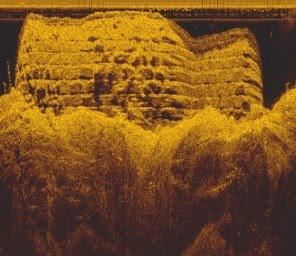 |
| Downscan of brigdepilar, 83/200/455/800-HDI |
 |
| Downscan of old fence-like structure with 83/200/455/800-HDI |
Läs mer...
(Detta inlägg har postats automatiskt)
